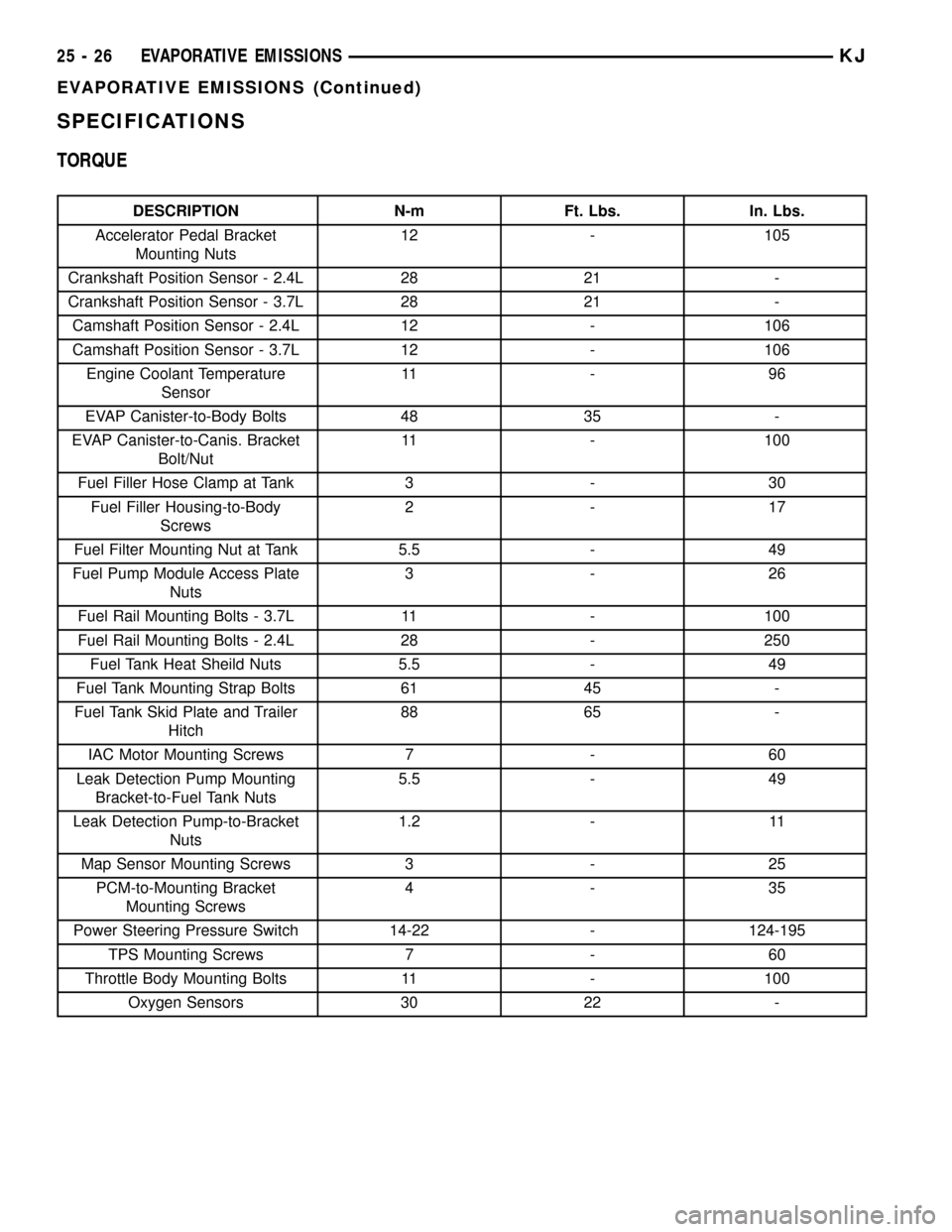2002 JEEP LIBERTY fuel pressure
[x] Cancel search: fuel pressurePage 1724 of 1803

LEAK DETECTION PUMP MONITOR (IF EQUIPPED)
The leak detection assembly incorporates two pri-
mary functions: it must detect a leak in the evapora-
tive system and seal the evaporative system so the
leak detection test can be run.
The primary components within the assembly are:
A three port solenoid that activates both of the func-
tions listed above; a pump which contains a switch,
two check valves and a spring/diaphragm, a canister
vent valve (CVV) seal which contains a spring loaded
vent seal valve.
Immediately after a cold start, between predeter-
mined temperature thresholds limits, the three port
solenoid is briefly energized. This initializes the
pump by drawing air into the pump cavity and also
closes the vent seal. During non test conditions the
vent seal is held open by the pump diaphragm
assembly which pushes it open at the full travel posi-
tion. The vent seal will remain closed while the
pump is cycling due to the reed switch triggering of
the three port solenoid that prevents the diaphragm
assembly from reaching full travel. After the brief
initialization period, the solenoid is de-energized
allowing atmospheric pressure to enter the pump
cavity, thus permitting the spring to drive the dia-
phragm which forces air out of the pump cavity and
into the vent system. When the solenoid is energized
and de energized, the cycle is repeated creating flow
in typical diaphragm pump fashion. The pump is con-
trolled in 2 modes:
Pump Mode:The pump is cycled at a fixed rate to
achieve a rapid pressure build in order to shorten the
overall test length.
Test Mode:The solenoid is energized with a fixed
duration pulse. Subsequent fixed pulses occur when
the diaphragm reaches the Switch closure point.
The spring in the pump is set so that the system
will achieve an equalized pressure of about 7.5º
water. The cycle rate of pump strokes is quite rapid
as the system begins to pump up to this pressure. As
the pressure increases, the cycle rate starts to drop
off. If there is no leak in the system, the pump would
eventually stop pumping at the equalized pressure. If
there is a leak, it will continue to pump at a rate rep-
resentative of the flow characteristic of the size of the
leak. From this information we can determine if the
leak is larger than the required detection limit (cur-
rently set at .040º orifice by CARB). If a leak is
revealed during the leak test portion of the test, the
test is terminated at the end of the test mode and no
further system checks will be performed.
After passing the leak detection phase of the test,
system pressure is maintained by turning on the
LDP's solenoid until the purge system is activated.
Purge activation in effect creates a leak. The cycle
rate is again interrogated and when it increases dueto the flow through the purge system, the leak check
portion of the diagnostic is complete.
The canister vent valve will unseal the system
after completion of the test sequence as the pump
diaphragm assembly moves to the full travel position.
Evaporative system functionality will be verified by
using the stricter evap purge flow monitor. At an
appropriate warm idle the LDP will be energized to
seal the canister vent. The purge flow will be clocked
up from some small value in an attempt to see a
shift in the 02 control system. If fuel vapor, indicated
by a shift in the 02 control, is present the test is
passed. If not, it is assumed that the purge system is
not functioning in some respect. The LDP is again
turned off and the test is ended.
MISFIRE MONITOR
Excessive engine misfire results in increased cata-
lyst temperature and causes an increase in HC emis-
sions. Severe misfires could cause catalyst damage.
To prevent catalytic convertor damage, the PCM
monitors engine misfire.
The Powertrain Control Module (PCM) monitors
for misfire during most engine operating conditions
(positive torque) by looking at changes in the crank-
shaft speed. If a misfire occurs the speed of the
crankshaft will vary more than normal.
FUEL SYSTEM MONITOR
To comply with clean air regulations, vehicles are
equipped with catalytic converters. These converters
reduce the emission of hydrocarbons, oxides of nitro-
gen and carbon monoxide. The catalyst works best
when the Air Fuel (A/F) ratio is at or near the opti-
mum of 14.7 to 1.
The PCM is programmed to maintain the optimum
air/fuel ratio of 14.7 to 1. This is done by making
short term corrections in the fuel injector pulse width
based on the O2S sensor output. The programmed
memory acts as a self calibration tool that the engine
controller uses to compensate for variations in engine
specifications, sensor tolerances and engine fatigue
over the life span of the engine. By monitoring the
actual fuel-air ratio with the O2S sensor (short term)
and multiplying that with the program long-term
(adaptive) memory and comparing that to the limit,
it can be determined whether it will pass an emis-
sions test. If a malfunction occurs such that the PCM
cannot maintain the optimum A/F ratio, then the
MIL will be illuminated.
CATALYST MONITOR
To comply with clean air regulations, vehicles are
equipped with catalytic converters. These converters
reduce the emission of hydrocarbons, oxides of nitro-
gen and carbon monoxide.
25 - 18 EMISSIONS CONTROLKJ
EMISSIONS CONTROL (Continued)
Page 1726 of 1803

an associated limp in will take two trips to illumi-
nate the MIL.
Refer to the Diagnostic Trouble Codes Description
Charts in this section and the appropriate Power-
train Diagnostic Procedure Manual for diagnostic
procedures.
DESCRIPTION - NON-MONITORED CIRCUITS
The PCM does not monitor the following circuits,
systems and conditions that could have malfunctions
causing driveability problems. The PCM might not
store diagnostic trouble codes for these conditions.
However, problems with these systems may cause the
PCM to store diagnostic trouble codes for other sys-
tems or components. For example, a fuel pressure
problem will not register a fault directly, but could
cause a rich/lean condition or misfire. This could
cause the PCM to store an oxygen sensor or misfire
diagnostic trouble code
FUEL PRESSURE
The fuel pressure regulator controls fuel system
pressure. The PCM cannot detect a clogged fuel
pump inlet filter, clogged in-line fuel filter, or a
pinched fuel supply or return line. However, these
could result in a rich or lean condition causing the
PCM to store an oxygen sensor or fuel system diag-
nostic trouble code.
SECONDARY IGNITION CIRCUIT
The PCM cannot detect an inoperative ignition coil,
fouled or worn spark plugs, ignition cross firing, or
open spark plug cables.
CYLINDER COMPRESSION
The PCM cannot detect uneven, low, or high engine
cylinder compression.
EXHAUST SYSTEM
The PCM cannot detect a plugged, restricted or
leaking exhaust system, although it may set a fuel
system fault.
FUEL INJECTOR MECHANICAL MALFUNCTIONS
The PCM cannot determine if a fuel injector is
clogged, the needle is sticking or if the wrong injectoris installed. However, these could result in a rich or
lean condition causing the PCM to store a diagnostic
trouble code for either misfire, an oxygen sensor, or
the fuel system.
EXCESSIVE OIL CONSUMPTION
Although the PCM monitors engine exhaust oxygen
content when the system is in closed loop, it cannot
determine excessive oil consumption.
THROTTLE BODY AIRFLOW
The PCM cannot detect a clogged or restricted air
cleaner inlet or filter element.
VACUUM ASSIST
The PCM cannot detect leaks or restrictions in the
vacuum circuits of vacuum assisted engine control
system devices. However, these could cause the PCM
to store a MAP sensor diagnostic trouble code and
cause a high idle condition.
PCM SYSTEM GROUND
The PCM cannot determine a poor system ground.
However, one or more diagnostic trouble codes may
be generated as a result of this condition. The mod-
ule should be mounted to the body at all times, also
during diagnostic.
PCM CONNECTOR ENGAGEMENT
The PCM may not be able to determine spread or
damaged connector pins. However, it might store
diagnostic trouble codes as a result of spread connec-
tor pins.
DESCRIPTION - HIGH AND LOW LIMITS
The PCM compares input signal voltages from each
input device with established high and low limits for
the device. If the input voltage is not within limits
and other criteria are met, the PCM stores a diagnos-
tic trouble code in memory. Other diagnostic trouble
code criteria might include engine RPM limits or
input voltages from other sensors or switches that
must be present before verifying a diagnostic trouble
code condition.
DESCRIPTION - LOAD VALUE
ENGINE IDLE/NEUTRAL 2500 RPM/NEUTRAL
All Engines 2% to 8% of Maximum Load 9% to 17% of Maximum Load
25 - 20 EMISSIONS CONTROLKJ
EMISSIONS CONTROL (Continued)
Page 1732 of 1803

SPECIFICATIONS
TORQUE
DESCRIPTION N-m Ft. Lbs. In. Lbs.
Accelerator Pedal Bracket
Mounting Nuts12 - 105
Crankshaft Position Sensor - 2.4L 28 21 -
Crankshaft Position Sensor - 3.7L 28 21 -
Camshaft Position Sensor - 2.4L 12 - 106
Camshaft Position Sensor - 3.7L 12 - 106
Engine Coolant Temperature
Sensor11 - 9 6
EVAP Canister-to-Body Bolts 48 35 -
EVAP Canister-to-Canis. Bracket
Bolt/Nut11 - 100
Fuel Filler Hose Clamp at Tank 3 - 30
Fuel Filler Housing-to-Body
Screws2-17
Fuel Filter Mounting Nut at Tank 5.5 - 49
Fuel Pump Module Access Plate
Nuts3-26
Fuel Rail Mounting Bolts - 3.7L 11 - 100
Fuel Rail Mounting Bolts - 2.4L 28 - 250
Fuel Tank Heat Sheild Nuts 5.5 - 49
Fuel Tank Mounting Strap Bolts 61 45 -
Fuel Tank Skid Plate and Trailer
Hitch88 65 -
IAC Motor Mounting Screws 7 - 60
Leak Detection Pump Mounting
Bracket-to-Fuel Tank Nuts5.5 - 49
Leak Detection Pump-to-Bracket
Nuts1.2 - 11
Map Sensor Mounting Screws 3 - 25
PCM-to-Mounting Bracket
Mounting Screws4-35
Power Steering Pressure Switch 14-22 - 124-195
TPS Mounting Screws 7 - 60
Throttle Body Mounting Bolts 11 - 100
Oxygen Sensors 30 22 -
25 - 26 EVAPORATIVE EMISSIONSKJ
EVAPORATIVE EMISSIONS (Continued)
Page 1733 of 1803

EVAP/PURGE SOLENOID
DESCRIPTION
The duty cycle EVAP canister purge solenoid (DCP)
is located in the engine compartment. It is attached
to a bracket located between the battery and the
Power Distribution Center (PDC). The EVAP system
test port is located near the solenoid.
OPERATION
The duty cycle EVAP canister purge solenoid (DCP)
regulates the rate of vapor flow from the EVAP can-
ister to the intake manifold. The Powertrain Control
Module (PCM) operates the solenoid.
During the cold start warm-up period and the hot
start time delay, the PCM does not energize the sole-
noid. When de-energized, no vapors are purged. The
PCM de-energizes the solenoid during open loop oper-
ation.
The engine enters closed loop operation after it
reaches a specified temperature and the time delay
ends. During closed loop operation, the PCM cycles
(energizes and de-energizes) the solenoid 5 or 10
times per second, depending upon operating condi-
tions. The PCM varies the vapor flow rate by chang-
ing solenoid pulse width. Pulse width is the amount
of time that the solenoid is energized. The PCM
adjusts solenoid pulse width based on engine operat-
ing condition.
REMOVAL
The duty cycle EVAP canister purge solenoid (DCP)
is located in the engine compartment (Fig. 2). It is
attached to a bracket located between the battery
and the Power Distribution Center (PDC). The EVAP
system test port is located near the solenoid (Fig. 2).
(1) Disconnect electrical wiring connector at sole-
noid.
(2) Disconnect vacuum harness at solenoid.
(3) Remove solenoid and its support bracket (pull
straight up).
INSTALLATION
(1) Slip EVAP canister purge solenoid onto its
mounting bracket.
(2) Connect vacuum harness to solenoid.
(3) Connect electrical connector to solenoid.
FUEL FILLER CAP
DESCRIPTION
The plastic fuel tank filler tube cap is threaded
onto the end of the fuel fill tube. All models are
equipped with a 1/4 turn cap.
OPERATION
The loss of any fuel or vapor out of fuel filler tube
is prevented by the use of a pressure-vacuum fuel fill
cap. Relief valves inside the cap will release fuel tank
pressure at predetermined pressures. Fuel tank vac-
uum will also be released at predetermined values.
This cap must be replaced by a similar unit if
replacement is necessary. This is in order for the sys-
tem to remain effective.
CAUTION: Remove fill cap before servicing any fuel
system component to relieve tank pressure. If
equipped with an ORVR system and a Leak Detec-
tion Pump (LDP), the cap must be tightened
securely. If cap is left loose, a Diagnostic Trouble
Code (DTC) may be set.
LEAK DETECTION PUMP
DESCRIPTION
The Leak Detection Pump (LDP) is bolted to the
front of the fuel tank (Fig. 1).
The Leak Detection Pump (LDP) is used only with
certain emission packages.
The LDP is a device used to detect a leak in the
evaporative system.
Fig. 2 EVAP / PURGE SOLENOID LOCATION
1 - BATTERY
2 - EVAP/PURGE SOLENOID LOCATION
3 - MOUNTING BRACKET
4 - POWER DISTRIBUTION CENTER (PDC)
5 - SOLENOID ELECTRICAL CONNECTOR
6 - EVAP SYSTEM TEST PORT
KJEVAPORATIVE EMISSIONS 25 - 27
Page 1734 of 1803

The pump contains a 3 port solenoid, a pump that
contains a switch, a spring loaded canister vent valve
seal, 2 check valves and a spring/diaphragm.
OPERATION
Immediately after a cold start, engine temperature
between 40ÉF and 86ÉF, the 3 port solenoid is briefly
energized. This initializes the pump by drawing air
into the pump cavity and also closes the vent seal.
During non-test test conditions, the vent seal is held
open by the pump diaphragm assembly which pushes
it open at the full travel position. The vent seal will
remain closed while the pump is cycling. This is due
to the operation of the 3 port solenoid which prevents
the diaphragm assembly from reaching full travel.
After the brief initialization period, the solenoid is
de-energized, allowing atmospheric pressure to enter
the pump cavity. This permits the spring to drive the
diaphragm which forces air out of the pump cavity
and into the vent system. When the solenoid is ener-
gized and de-energized, the cycle is repeated creating
flow in typical diaphragm pump fashion. The pump
is controlled in 2 modes:
PUMP MODE:The pump is cycled at a fixed rate
to achieve a rapid pressure build in order to shorten
the overall test time.
TEST MODE:The solenoid is energized with a
fixed duration pulse. Subsequent fixed pulses occur
when the diaphragm reaches the switch closure
point.
The spring in the pump is set so that the system
will achieve an equalized pressure of about 7.5 inches
of water.
When the pump starts, the cycle rate is quite high.
As the system becomes pressurized pump rate drops.
If there is no leak the pump will quit. If there is a
leak, the test is terminated at the end of the test
mode.
If there is no leak, the purge monitor is run. If the
cycle rate increases due to the flow through the
purge system, the test is passed and the diagnostic is
complete.
The canister vent valve will unseal the system
after completion of the test sequence as the pump
diaphragm assembly moves to the full travel position.
REMOVAL
The Leak Detection Pump (LDP) is attached (bolt-
ed) to the front of the fuel tank (Fig. 3). The LDP
fresh air filter is located on the end of a hose. This
hose is attached to the fuel fill tube assembly below
and near the fuel fill opening (Fig. 1). The LDP and
LDP filter are typically replaced (serviced) as one
unit.
(1) Raise vehicle.(2) Carefully remove two 3/4º vent hoses at sides
of LDP.
(3) Carefully remove other vapor/vacuum hoses
from LDP.
(4) Place a hydraulic jack under fuel tank.
(5) Loosen 2 fuel tank strap mounting bolts at
front of tank about 10 turns.
(6) Lower front of fuel tank about 1/2º.
(7) Remove 2 LDP mounting nuts (Fig. 3) and
lower LDP slightly to gain access to electrical connec-
tor (Fig. 4).
(8) Disconnect electrical connector at LDP. To dis-
connect: Slide red colored tab upward. Push on black
colored tab while removing connector.
(9) Remove LDP from vehicle.
INSTALLATION
The Leak Detection Pump (LDP) is attached (bolt-
ed) to the front of the fuel tank. The LDP filter is
located on the end of a hose. This hose is attached to
the fuel fill tube assembly below and near the fuel
fill opening. The LDP and LDP filter are replaced
(serviced) as one unit.
(1) Install electrical connector to LDP. Push red
colored tab downward to lock connector to LDP.
(2) Position LDP and LDP bracket to fuel tank
mounting studs and install 2 nuts. Tighten nuts to 1
N´m (11 in. lbs.) torque.
(3) Raise fuel tank to body and tighten 2 strap
bolts to 61 N´m (45 ft. lbs.) torque.
Fig. 3 LDP LOCATION / MOUNTING
1 - LDP
2 - FLOW MANAGEMENT VALVE
3 - MOUNTING NUTS
4 - FRONT OF FUEL TANK
25 - 28 EVAPORATIVE EMISSIONSKJ
LEAK DETECTION PUMP (Continued)
Page 1739 of 1803

VACUUM LINES
DESCRIPTION
A vacuum schematic for emission related items can
be found on the VECI label. Refer to Vehicle Emis-
sion Control Information (VECI) Label for label loca-
tion.
VAPOR CANISTER
DESCRIPTION
A maintenance free, EVAP canister is used on all
gasoline powered models. The EVAP canister is
located near the left/front corner of the fuel tank.
OPERATION
The EVAP canister is filled with granules of an
activated carbon mixture. Fuel vapors entering the
EVAP canister are absorbed by the charcoal granules.
The canister serves two functions: as a temporary
fuel vapor storage point while refueling the vehicle
for the ORVR system, as a temporary vapor storage
point while the engine is running.
Fuel tank pressure vents into the EVAP canister.
Fuel vapors are temporarily held in the canister until
they can be drawn into the intake manifold. The duty
cycle EVAP canister purge solenoid allows the EVAP
canister to be purged at predetermined times and at
certain engine operating conditions.
Refer to ORVR for additional information.
REMOVAL
The EVAP canister is located near front of fuel
tank and next to left/rear spring. (Fig. 13).
(1) Raise vehicle.
(2) Disconnect vacuum hoses/lines at EVAP canis-
ter. Note location of lines before removal.
(3) Remove EVAP canister and mounting bracket
assembly from body (2 bolts).
(4) Remove canister-to-mounting bracket bolt.
(5) Slide 2 canister mounting pins from mounting
bracket (Fig. 14).
INSTALLATION
(1) Slide 2 canister mounting pins into mounting
bracket (Fig. 14).
(2) Install canister-to-mounting bracket bolt.
(3) Position canister and bracket assembly to body.
(4) Install 2 mounting bracket bolts. Tighten to 47
N´m (35 ft. lbs.) torque.
(5) Connect vacuum hoses/lines at EVAP canister.
(6) Lower vehicle.
Fig. 13 EVAP CANISTER LOCATION
1 - LEFT/REAR SPRING
2 - EVAP CANISTER
3 - MOUNTING BRACKET
4 - BRACKET BOLTS
5 - VACUUM LINES
Fig. 14 EVAP CANISTER MOUNTING PINS
1 - MOUNTING PINS
2 - MOUNTING BRACKET
3 - EVAP CANISTER
KJEVAPORATIVE EMISSIONS 25 - 33
Page 1740 of 1803

ABS - DESCRIPTION, BRAKES...........5-32
ABS - OPERATION, BRAKES.............5-32
ABS - SPECIFICATIONS, BRAKES.........5-33
ABS BRAKE BLEEDING - STANDARD
PROCEDURE.........................5-33
ABS INDICATOR - DESCRIPTION.........8J-11
ABS INDICATOR - OPERATION..........8J-11
A/C APPLICATION TABLE,
SPECIFICATIONS......................24-9
A/C COMPRESSOR CLUTCH -
INSPECTION........................24-14
A/C COMPRESSOR CLUTCH -
INSTALLATION.......................24-14
A/C COMPRESSOR CLUTCH - REMOVAL . . 24-13
A/C COMPRESSOR CLUTCH BREAK-IN -
STANDARD PROCEDURE...............24-12
A/C COMPRESSOR CLUTCH COIL -
DIAGNOSIS AND TESTING.............24-12
A/C COMPRESSOR CLUTCH RELAY -
DESCRIPTION.......................24-15
A/C COMPRESSOR CLUTCH RELAY -
INSTALLATION.......................24-16
A/C COMPRESSOR CLUTCH RELAY -
OPERATION.........................24-15
A/C COMPRESSOR CLUTCH RELAY -
REMOVAL..........................24-16
A/C COMPRESSOR NOISE - DIAGNOSIS
AND TESTING.......................24-42
A/C CONDENSER - DESCRIPTION........24-45
A/C CONDENSER - INSTALLATION.......24-46
A/C CONDENSER - OPERATION...........24-45
A/C CONDENSER - REMOVAL...........24-45
A/C DISCHARGE LINE - INSTALLATION . . . 24-47
A/C DISCHARGE LINE - REMOVAL.......24-46
A/C EVAPORATOR - DESCRIPTION.......24-49
A/C EVAPORATOR - INSTALLATION......24-49
A/C EVAPORATOR - OPERATION.........24-49
A/C EVAPORATOR - REMOVAL..........24-49
A/C HEATER CONTROL - DESCRIPTION . . . 24-16
A/C HEATER CONTROL - INSTALLATION . . . 24-17
A/C HEATER CONTROL - REMOVAL......24-17
A/C HIGH PRESSURE SWITCH -
DESCRIPTION.......................24-17
A/C HIGH PRESSURE SWITCH -
DIAGNOSIS AND TESTING.............24-18
A/C HIGH PRESSURE SWITCH -
INSTALLATION.......................24-18
A/C HIGH PRESSURE SWITCH -
OPERATION.........................24-18
A/C HIGH PRESSURE SWITCH -
REMOVAL..........................24-18
A/C LIQUID LINE - INSTALLATION.......24-47
A/C LIQUID LINE - REMOVAL...........24-47
A/C LOW PRESSURE SWITCH -
DESCRIPTION.......................24-18
A/C LOW PRESSURE SWITCH -
DIAGNOSIS AND TESTING.............24-19
A/C LOW PRESSURE SWITCH -
INSTALLATION.......................24-19
A/C LOW PRESSURE SWITCH -
OPERATION.........................24-18
A/C LOW PRESSURE SWITCH -
REMOVAL..........................24-19
A/C ORIFICE TUBE - DESCRIPTION.......24-50
A/C ORIFICE TUBE - INSTALLATION......24-50
A/C ORIFICE TUBE - OPERATION........24-50
A/C ORIFICE TUBE - REMOVAL..........24-50
A/C PERFORMANCE - DIAGNOSIS AND
TESTING............................24-2
A/C SUCTION LINE - INSTALLATION......24-49
A/C SUCTION LINE - REMOVAL.........24-48
ACCELERATOR PEDAL - INSTALLATION . . . 14-30
ACCELERATOR PEDAL - REMOVAL.......14-29
ACCESS PANEL - DESCRIPTION, LATCH . . 23-139
ACCESS PANEL - INSTALLATION, LATCH . 23-139
ACCESS PANEL - REMOVAL, LATCH.....23-139
ACCUMULATOR - DESCRIPTION.........24-51
ACCUMULATOR - INSTALLATION........24-51
ACCUMULATOR - OPERATION..........24-51
ACCUMULATOR - REMOVAL
............24-51
ACTUATION TEST MODE - DESCRIPTION,
CIRCUIT
.............................25-2
ACTUATOR - INSTALLATION, BLEND
DOOR
.............................24-20
ACTUATOR - INSTALLATION, FLOOR -
DEFROST DOOR
.....................24-25
ACTUATOR - INSTALLATION, PANEL
DOOR
.............................24-25ACTUATOR - INSTALLATION,
RECIRCULATION DOOR................24-26
ACTUATOR - REMOVAL, BLEND DOOR....24-20
ACTUATOR - REMOVAL, FLOOR -
DEFROST DOOR.....................24-24
ACTUATOR - REMOVAL, PANEL DOOR....24-24
ACTUATOR - REMOVAL, RECIRCULATION
DOOR.............................24-26
ADAPTER - INSTALLATION, DISC BRAKE
CALIPER............................5-18
ADAPTER - REMOVAL, DISC BRAKE
CALIPER............................5-18
ADAPTER HOUSING SEAL -
INSTALLATION......................21-124
ADAPTER HOUSING SEAL - REMOVAL . . . 21-124
ADAPTOR - REMOVAL, DEFROST
DUCT/DEMISTER.....................24-32
ADHESIVE LOCATIONS -
SPECIFICATIONS, WELD AND
STRUCTURAL........................23-9
ADJUSTER - DIAGNOSIS AND TESTING,
HYDRAULIC LASH.................9-19,9-30
ADJUSTER - INSTALLATION, SEAT BELT
TURNING LOOP.....................8O-38
ADJUSTER - REMOVAL, SEAT BELT
TURNING LOOP.....................8O-37
ADJUSTMENT - STANDARD
PROCEDURE, CAMBER AND CASTER.......2-5
ADJUSTMENT - STANDARD
PROCEDURE, CAMBER, CASTER AND
TOE .................................2-5
ADJUSTMENT - STANDARD
PROCEDURE, COMPASS VARIATION......8M-3
ADJUSTMENT - STANDARD
PROCEDURE, TOE......................2-5
ADJUSTMENT, ADJUSTMENTS . . . 23-119,23-124,
23-131
ADJUSTMENT, ADJUSTMENTS...........3-55
ADJUSTMENT, ADJUSTMENTS -
SUNROOF GLASS PANEL.............23-178
ADJUSTMENT, FRONT FOG LAMP UNIT . . . 8L-25
ADJUSTMENT, HEADLAMP UNIT.........8L-42
ADJUSTMENT, LOCK OUT...............5-30
ADJUSTMENT, REAR DRUM BRAKE.......5-12
ADJUSTMENTS - ADJUSTMENT . . 23-119,23-124,
23-131
ADJUSTMENTS - ADJUSTMENT..........3-55
ADJUSTMENTS - SUNROOF GLASS
PANEL ADJUSTMENT................23-178
ADJUSTMENTS, FRONT AXLE - 186FIA....3-25
ADJUSTMENTS, GEARSHIFT CABLE.....21-130
ADJUSTMENTS, PARK-INTERLOCK
CABLE............................21-154
ADJUSTMENTS, REAR AXLE - 8 1/4 .......3-92
AFTER A SUPPLEMENTAL RESTRAINT
DEPLOYMENT - STANDARD
PROCEDURE, SERVICE.................8O-6
AIR CHECKING TRANSMISSION CLUTCH
OPERATION - DIAGNOSIS AND
TESTING...........................21-80
AIR CONDITIONER - DESCRIPTION,
HEATER .............................24-1
AIR CONDITIONER - OPERATION,
HEATER .............................24-2
AIR CONTROL MOTOR - DESCRIPTION,
IDLE...............................14-35
AIR CONTROL MOTOR - INSTALLATION,
IDLE...............................14-36
AIR CONTROL MOTOR - OPERATION,
IDLE...............................14-35
AIR CONTROL MOTOR - REMOVAL, IDLE . . 14-36
AIR TEMPERATURE SENSOR -
DESCRIPTION, INTAKE................14-36
AIR TEMPERATURE SENSOR -
INSTALLATION, INTAKE................14-38
AIR TEMPERATURE SENSOR -
OPERATION, INTAKE..................14-36
AIR TEMPERATURE SENSOR -
REMOVAL, INTAKE...................14-37
AIRBAG - DESCRIPTION, DRIVER........8O-17
AIRBAG - DESCRIPTION, PASSENGER....8O-27
AIRBAG - DESCRIPTION, SIDE CURTAIN . . 8O-38
AIRBAG - INSTALLATION, DRIVER.......8O-20
AIRBAG - INSTALLATION, PASSENGER
. . . 8O-29
AIRBAG - INSTALLATION, SIDE CURTAIN
. . 8O-41
AIRBAG - OPERATION, DRIVER
.........8O-18
AIRBAG - OPERATION, PASSENGER
......8O-27
AIRBAG - OPERATION, SIDE CURTAIN
....8O-39AIRBAG - REMOVAL, DRIVER...........8O-19
AIRBAG - REMOVAL, PASSENGER.......8O-28
AIRBAG - REMOVAL, SIDE CURTAIN.....8O-40
AIRBAG CONTROL MODULE -
DESCRIPTION........................8O-9
AIRBAG CONTROL MODULE -
DESCRIPTION, SIDE IMPACT...........8O-43
AIRBAG CONTROL MODULE -
INSTALLATION......................8O-12
AIRBAG CONTROL MODULE -
INSTALLATION, SIDE IMPACT...........8O-45
AIRBAG CONTROL MODULE -
OPERATION.........................8O-10
AIRBAG CONTROL MODULE -
OPERATION, SIDE IMPACT.............8O-43
AIRBAG CONTROL MODULE - REMOVAL . . 8O-11
AIRBAG CONTROL MODULE - REMOVAL,
SIDE IMPACT.......................8O-44
AIRBAG DOOR - INSTALLATION,
PASSENGER........................8O-30
AIRBAG DOOR - REMOVAL, PASSENGER . . 8O-29
AIRBAG INDICATOR - DESCRIPTION......8J-12
AIRBAG INDICATOR - OPERATION.......8J-12
AIRBAG MOUNTING BRACKET -
INSTALLATION, PASSENGER...........8O-31
AIRBAG MOUNTING BRACKET -
REMOVAL, PASSENGER...............8O-31
AJAR INDICATOR - DESCRIPTION, DOOR . . 8J-17
AJAR INDICATOR - DESCRIPTION, GATE . . 8J-20
AJAR INDICATOR - DESCRIPTION,
GLASS..............................8J-21
AJAR INDICATOR - OPERATION, DOOR . . . 8J-17
AJAR INDICATOR - OPERATION, GATE....8J-20
AJAR INDICATOR - OPERATION, GLASS . . . 8J-21
AJAR SWITCH - DESCRIPTION, DOOR....8L-77
AJAR SWITCH - DESCRIPTION, FLIP-UP
GLASS.............................8L-77
AJAR SWITCH - DESCRIPTION, HOOD....8Q-11
AJAR SWITCH - DESCRIPTION,
TAILGATE...........................8L-82
AJAR SWITCH - DIAGNOSIS AND
TESTING, HOOD.....................8Q-12
AJAR SWITCH - INSTALLATION, HOOD . . . 8Q-12
AJAR SWITCH - OPERATION, DOOR......8L-77
AJAR SWITCH - OPERATION, FLIP-UP
GLASS.............................8L-77
AJAR SWITCH - OPERATION, HOOD.....8Q-12
AJAR SWITCH - OPERATION, TAILGATE . . . 8L-82
AJAR SWITCH - REMOVAL, HOOD.......8Q-12
AJAR SWITCH BRACKET -
INSTALLATION, HOOD.................8Q-13
AJAR SWITCH BRACKET - REMOVAL,
HOOD.............................8Q-13
AJAR SWITCH STRIKER -
INSTALLATION, HOOD.................8Q-14
AJAR SWITCH STRIKER - REMOVAL,
HOOD.............................8Q-13
ALIGNMENT - DESCRIPTION, WHEEL.......2-3
ALIGNMENT - OPERATION, WHEEL........2-3
ALIGNMENT, SPECIFICATIONS............2-6
ALUMINUM THREAD REPAIR -
STANDARD PROCEDURE...............21-81
AMBIENT TEMP SENSOR - DESCRIPTION . . 8M-9
AMBIENT TEMP SENSOR - OPERATION . . . 8M-9
AMBIENT TEMPERATURE SENSOR -
DIAGNOSIS AND TESTING..............8M-9
AMBIENT TEMPERATURE SENSOR
CIRCUIT - DIAGNOSIS AND TESTING.....8M-9
AMPERAGE TEST - DIAGNOSIS AND
TESTING, FUEL PUMP.................14-16
AMPLIFIER CHOKE AND RELAY -
DESCRIPTION........................8A-3
AMPLIFIER CHOKE AND RELAY -
DIAGNOSIS AND TESTING..............8A-4
AMPLIFIER CHOKE AND RELAY -
INSTALLATION.......................8A-4
AMPLIFIER CHOKE AND RELAY -
OPERATION..........................8A-3
AMPLIFIER CHOKE AND RELAY -
REMOVAL...........................8A-4
ANCHOR - DESCRIPTION, CHILD TETHER
. 8O-13
ANCHOR - OPERATION, CHILD TETHER
. . . 8O-13
ANGLE - STANDARD PROCEDURES,
PROPELLER SHAFT
.....................3-3
ANTENNA BODY & CABLE -
DESCRIPTION
........................8A-4
ANTENNA BODY & CABLE -
INSTALLATION
.......................8A-6
KJINDEX 1
Description Group-Page Description Group-Page Description Group-Page
Page 1743 of 1803

BRAKE CALIPERS - OPERATION, DISC.....5-14
BRAKE CALIPERS - REMOVAL, DISC......5-14
BRAKE COMPONENTS, SPECIFICATIONS....5-6
BRAKE DRUM - DIAGNOSIS AND
TESTING............................5-27
BRAKE DRUM MACHINING - STANDARD
PROCEDURES........................5-27
BRAKE FLUID CONTAMINATION -
DIAGNOSIS AND TESTING..............5-26
BRAKE FLUID, SPECIFICATIONS..........5-27
BRAKE HOSE - INSTALLATION, FRONT.....5-10
BRAKE HOSE - INSTALLATION, REAR......5-10
BRAKE HOSE - REMOVAL, REAR..........5-9
BRAKE INDICATOR - DESCRIPTION,
BRAKE/PARK........................8J-13
BRAKE INDICATOR - DIAGNOSIS AND
TESTING...........................8J-14
BRAKE INDICATOR - OPERATION,
BRAKE/PARK........................8J-13
BRAKE LAMP SWITCH - DESCRIPTION . . . 8L-16
BRAKE LAMP SWITCH - DIAGNOSIS
AND TESTING.......................8L-17
BRAKE LAMP SWITCH - INSTALLATION . . . 8L-18
BRAKE LAMP SWITCH - OPERATION.....8L-16
BRAKE LAMP SWITCH - REMOVAL......8L-17
BRAKE LINE AND HOSES - DIAGNOSIS
AND TESTING.........................5-8
BRAKE LINES - DESCRIPTION............5-8
BRAKE PADS - INSTALLATION, FRONT.....5-11
BRAKE PADS - REMOVAL, FRONT........5-11
BRAKE ROTOR - DIAGNOSIS AND
TESTING, DISC.......................5-18
BRAKE ROTOR - STANDARD
PROCEDURE, DISC....................5-19
BRAKE SHOES - INSTALLATION, DRUM....5-11
BRAKE SHOES - REMOVAL, DRUM.......5-11
BRAKE SYSTEM - DIAGNOSIS AND
TESTING, BASE........................5-3
BRAKE TRANSMISSION SHIFT
INTERLOCK SYSTEM - DESCRIPTION....21-124
BRAKE TRANSMISSION SHIFT
INTERLOCK SYSTEM - DIAGNOSIS
AND TESTING......................21-125
BRAKE TRANSMISSION SHIFT
INTERLOCK SYSTEM - OPERATION.....21-125
BRAKE/PARK BRAKE INDICATOR -
DESCRIPTION.......................8J-13
BRAKE/PARK BRAKE INDICATOR -
OPERATION.........................8J-13
BRAKES - ABS - DESCRIPTION...........5-32
BRAKES - ABS - OPERATION............5-32
BRAKES - ABS - SPECIFICATIONS........5-33
BRAKES - BASE - DESCRIPTION...........5-2
BRAKES - BASE - WARNING..............5-2
BRAKES, SPECIAL TOOLS - BASE.........5-7
BRAKING SYSTEM - DIAGNOSIS AND
TESTING, ANTILOCK...................5-33
BREAK-IN - STANDARD PROCEDURE,
A/C COMPRESSOR CLUTCH............24-12
BUCKLE - INSTALLATION, FRONT SEAT
BELT ..............................8O-26
BUCKLE - INSTALLATION, REAR SEAT
BELT ..............................8O-35
BUCKLE - REMOVAL, FRONT SEAT BELT . . 8O-25
BUCKLE - REMOVAL, REAR SEAT BELT . . . 8O-34
BUILT-IN INDICATOR TEST - STANDARD
PROCEDURE........................8F-10
BULB - INSTALLATION, ASH RECEIVER
LAMP..............................8L-71
BULB - INSTALLATION, CARGO LAMP....8L-73
BULB - INSTALLATION, CENTER HIGH
MOUNTED STOP LAMP................8L-19
BULB - INSTALLATION, COMPASS
MINI-TRIP ILLUMINATION..............8L-75
BULB - INSTALLATION, COURTESY
LAMP..............................8L-76
BULB - INSTALLATION, FRONT FOG
LAMP..............................8L-22
BULB - INSTALLATION, FRONT LAMP....8L-27
BULB - INSTALLATION, FRONT POSITION
LAMP..............................8L-28
BULB - INSTALLATION, HEADLAMP
......8L-32
BULB - INSTALLATION, HEATER-A/C
CONTROL ILLUMINATION
..............8L-78
BULB - INSTALLATION, LICENSE PLATE
LAMP
..............................8L-45
BULB - INSTALLATION, READING LAMP
. . . 8L-79
BULB - INSTALLATION, REAR LAMP
.....8L-59BULB - INSTALLATION, REPEATER LAMP . . 8L-60
BULB - INSTALLATION, TRANSMISSION
RANGE INDICATOR ILLUMINATION.......8L-83
BULB - INSTALLATION, VANITY LAMP....8L-84
BULB - REMOVAL, ASH RECEIVER LAMP . . 8L-71
BULB - REMOVAL, CARGO LAMP........8L-72
BULB - REMOVAL, CENTER HIGH
MOUNTED STOP LAMP................8L-18
BULB - REMOVAL, COMPASS MINI-TRIP
ILLUMINATION......................8L-74
BULB - REMOVAL, COURTESY LAMP.....8L-75
BULB - REMOVAL, FRONT FOG LAMP....8L-21
BULB - REMOVAL, FRONT LAMP........8L-26
BULB - REMOVAL, FRONT POSITION
LAMP..............................8L-28
BULB - REMOVAL, HEADLAMP..........8L-31
BULB - REMOVAL, HEATER-A/C
CONTROL ILLUMINATION..............8L-78
BULB - REMOVAL, LICENSE PLATE
LAMP..............................8L-44
BULB - REMOVAL, READING LAMP......8L-79
BULB - REMOVAL, REAR LAMP.........8L-58
BULB - REMOVAL, REPEATER LAMP.....8L-60
BULB - REMOVAL, TRANSMISSION
RANGE INDICATOR ILLUMINATION.......8L-82
BULB - REMOVAL, VANITY LAMP........8L-83
BUMPER - INSTALLATION, JOUNCE.......2-19
BUMPER - REMOVAL, JOUNCE...........2-19
BURNT FLUID - DIAGNOSIS AND
TESTING, CAUSES OF................21-125
BUSHING - NV3550 - INSTALLATION,
EXTENSION HOUSING.................21-74
BUSHING - NV3550 - REMOVAL,
EXTENSION HOUSING.................21-73
BUSHINGS - INSTALLATION, STABILIZER
BAR.................................2-9
BUSHINGS - REMOVAL, STABILIZER BAR . . . 2-9
BUSHINGS, AND BALL JOINT -
DESCRIPTION, UPPER SUSPENSION
ARM ...............................2-20
BUSHINGS, AND BALL JOINT -
OPERATION, UPPER SUSPENSION
ARM ...............................2-20
CABLE - ADJUSTMENTS, GEARSHIFT....21-130
CABLE - ADJUSTMENTS, PARK-
INTERLOCK........................21-154
CABLE - DESCRIPTION.................8P-3
CABLE - DESCRIPTION, ANTENNA BODY . . . 8A-4
CABLE - DIAGNOSIS AND TESTING,
ANTENNA BODY......................8A-5
CABLE - DIAGNOSIS AND TESTING,
GEARSHIFT........................21-128
CABLE - INSTALLATION, ANTENNA BODY . . 8A-6
CABLE - INSTALLATION, GEARSHIFT....21-129
CABLE - INSTALLATION, INSTRUMENT
PANEL ANTENNA......................8A-8
CABLE - INSTALLATION, LATCH RELEASE . 23-120
CABLE - INSTALLATION, PARK -
INTERLOCK........................21-153
CABLE - INSTALLATION, THROTTLE
CONTROL..........................14-46
CABLE - OPERATION...................8P-3
CABLE - OPERATION, ANTENNA BODY.....8A-5
CABLE - REMOVAL, ANTENNA BODY......8A-6
CABLE - REMOVAL, GEARSHIFT........21-128
CABLE - REMOVAL, INSTRUMENT PANEL
ANTENNA...........................8A-7
CABLE - REMOVAL, LATCH RELEASE....23-120
CABLE - REMOVAL, PARK - INTERLOCK . 21-153
CABLE - REMOVAL, THROTTLE
CONTROL..........................14-45
CABLE RESISTANCE, 2.4L - SPARK PLUG . . . 8I-3
CABLES - DESCRIPTION, BATTERY.......8F-18
CABLES - DIAGNOSIS AND TESTING,
BATTERY...........................8F-19
CABLES - INSTALLATION...............5-30
CABLES - OPERATION, BATTERY........8F-18
CABLES - REMOVAL...................5-30
CALIBRATION - STANDARD PROCEDURE,
COMPASS...........................8M-2
CALIPER ADAPTER - INSTALLATION,
DISC BRAKE.........................5-18
CALIPER ADAPTER - REMOVAL, DISC
BRAKE
..............................5-18
CALIPERS - ASSEMBLY, DISC BRAKE
......5-16
CALIPERS - CLEANING, DISC BRAKE
......5-16
CALIPERS - DESCRIPTION, DISC BRAKE
. . . 5-13
CALIPERS - DISASSEMBLY, DISC BRAKE
. . . 5-14CALIPERS - INSPECTION, DISC BRAKE....5-16
CALIPERS - INSTALLATION, DISC BRAKE . . . 5-17
CALIPERS - OPERATION, DISC BRAKE.....5-14
CALIPERS - REMOVAL, DISC BRAKE......5-14
CAMBER AND CASTER ADJUSTMENT -
STANDARD PROCEDURE.................2-5
CAMBER, CASTER AND TOE
ADJUSTMENT - STANDARD
PROCEDURE..........................2-5
CAMSHAFT(S) - DESCRIPTION.......9-23,9-33
CAMSHAFT(S) - INSTALLATION......9-25,9-33
CAMSHAFT(S) - REMOVAL..........9-24,9-33
CANISTER - DESCRIPTION, VAPOR......25-33
CANISTER - INSTALLATION, VAPOR......25-33
CANISTER - OPERATION, VAPOR........25-33
CANISTER - REMOVAL, VAPOR..........25-33
CAP - CLEANING, RADIATOR PRESSURE . . . 7-25
CAP - DESCRIPTION, FUEL FILLER.......25-27
CAP - DESCRIPTION, RADIATOR
PRESSURE..........................7-25
CAP - DIAGNOSIS AND TESTING,
RADIATOR PRESSURE.................7-25
CAP - INSPECTION, RADIATOR
PRESSURE..........................7-25
CAP - INSTALLATION, INSTRUMENT
PANEL END........................23-153
CAP - OPERATION, FUEL FILLER........25-27
CAP - OPERATION, RADIATOR
PRESSURE..........................7-25
CAP - REMOVAL, INSTRUMENT PANEL
END ..............................23-153
CAPACITIES - SPECIFICATIONS, FLUID......0-4
CAPACITOR - DESCRIPTION, IGNITION
COIL...............................8I-16
CAPACITOR - INSTALLATION, IGNITION
COIL...............................8I-16
CAPACITOR - OPERATION, IGNITION
COIL...............................8I-16
CAPACITOR - REMOVAL, IGNITION COIL . . . 8I-16
CAPACITY - SPECIFICATIONS, CHARGE . . . 24-42
CAPACITY TEST - DIAGNOSIS AND
TESTING, FUEL PUMP.................14-15
CARDAN UNIVERSAL JOINTS -
ASSEMBLY, SINGLE.....................3-9
CARDAN UNIVERSAL JOINTS -
DISASSEMBLY, SINGLE..................3-8
CARGO LAMP BULB - INSTALLATION.....8L-73
CARGO LAMP BULB - REMOVAL........8L-72
CARGO LAMP SWITCH - INSTALLATION . . 8L-74
CARGO LAMP SWITCH - REMOVAL......8L-73
CARGO LAMP UNIT - INSTALLATION.....8L-74
CARGO LAMP UNIT - REMOVAL.........8L-74
CARPETS AND FLOOR MATS -
INSTALLATION......................23-158
CARPETS AND FLOOR MATS - REMOVAL . 23-158
CASE - NV231 - ASSEMBLY, TRANSFER . . 21-194
CASE - NV231 - CLEANING, TRANSFER . . 21-190
CASE - NV231 - DESCRIPTION,
TRANSFER............................0-3
CASE - NV231 - DESCRIPTION,
TRANSFER.........................21-178
CASE - NV231 - DIAGNOSIS AND
TESTING, TRANSFER.................21-180
CASE - NV231 - DISASSEMBLY,
TRANSFER.........................21-182
CASE - NV231 - INSPECTION, TRANSFER . 21-190
CASE - NV231 - INSTALLATION,
TRANSFER.........................21-205
CASE - NV231 - OPERATION, TRANSFER
. 21-179
CASE - NV231 - REMOVAL, TRANSFER
. . 21-181
CASE - NV242 - ASSEMBLY, TRANSFER
. . 21-230
CASE - NV242 - CLEANING, TRANSFER
. . 21-227
CASE - NV242 - DESCRIPTION,
TRANSFER
............................0-3
CASE - NV242 - DESCRIPTION,
TRANSFER
.........................21-215
CASE - NV242 - DIAGNOSIS AND
TESTING, TRANSFER
.................21-216
CASE - NV242 - DISASSEMBLY,
TRANSFER
.........................21-218
CASE - NV242 - INSPECTION, TRANSFER
. 21-228
CASE - NV242 - INSTALLATION,
TRANSFER
.........................21-243
CASE - NV242 - OPERATION, TRANSFER
. 21-215
CASE - NV242 - REMOVAL, TRANSFER
. . 21-217
CASE BEARINGS - INSTALLATION,
DIFFERENTIAL
...............3-110,3-44,3-79
4 INDEXKJ
Description Group-Page Description Group-Page Description Group-Page